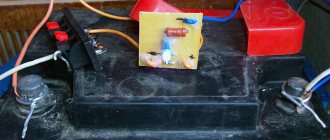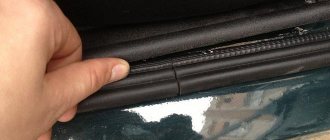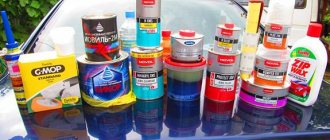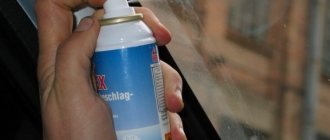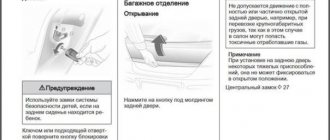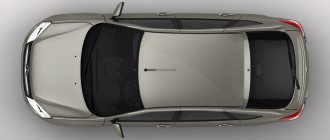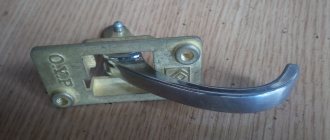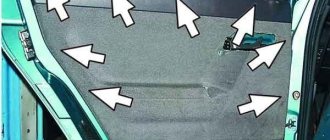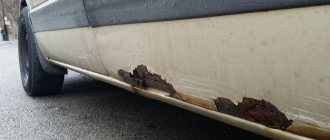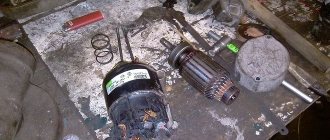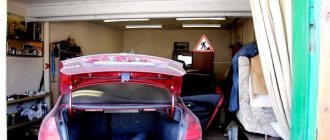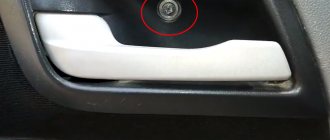The durable metal surface of new or old cars is coated with special anti-corrosion agents. This allows, under conditions of constant use, to extend the service life of the car body for a long time.
The production volumes of anti-corrosion coatings continue to grow because all means cannot protect even the highest quality car from the oxidative effects of air, water and time. With a skillful approach and regular care of the condition of the car, when applying an anti-corrosion coating to the car, careful car owners can manage to keep the car untouched by rust for a significant period of time.
The most vulnerable places
Corrosion is the process of destruction of metals. Oxidation occurs due to electrochemical, physicochemical and/or chemical interaction with other substances in the external environment - oxygen and water. The most vulnerable areas of a car to rust are those that are under constant and long-term exposure to external factors.
The open surfaces of the car are subject to mechanical stress and are constantly in contact with atmospheric air containing oxygen. Hard-to-reach areas of the car body cannot always dry quickly after moisture enters, and therefore are also subject to the destructive effects of oxidizing processes.
The most vulnerable places for corrosion in a car are the following:
There are always microcracks in places where car body parts are welded. They are the initial sources of corrosion, especially in the presence of high levels of humidity. In this case, water turns into ice in winter and, increasing in volume, contributes to the appearance of a crack in the seam and its subsequent increase and cracking.
- The underbody of the car, the surfaces of the wheel arches, the exhaust pipe, the muffler, the wheel arches, the sills.
The bottom, lower part of the doors and other parts of the car into which crushed stone and other debris flies from the road are constantly exposed to increased exposure to streams of dirt and sand quickly moving from under the wheels, which enhances the corrosive effect. These places primarily need anti-corrosion treatment.
- Engine and exhaust system.
In conditions of constant operation of the car engine and the exhaust system, which is closely connected with it, permanent conditions of elevated temperatures and high humidity are created, so corrosion also occurs in this part of the car.
The car interior and internal cavities remain wet and dirty even after several short trips around the city.
It is worth noting that despite similar processes occurring during vehicle operation, vulnerable areas are treated with different solutions. Since the nature and intensity of pollution is heterogeneous, each detail requires an individual approach.
Hidden and hard-to-reach car cavities are treated with liquid oils, wax-containing and paraffin-containing elastic automotive products. Oily car products fill cracks, displace moisture, periodically moving along the surface as the car moves. Substances with a high content of paraffin and wax contain a solvent that gradually evaporates and an inhibitor remaining on the surface, that is, a corrosion retardant.
External surfaces need to be treated with hardening compounds, and internal, hard-to-reach places - on the contrary, with liquid, non-hardening substances.
BBasiliuss › Blog › Do-it-yourself anti-corrosion treatment: rust, come on, goodbye!
How long the body remains intact is how long the car can last.
You can survive the rest, even engine failure, since repairing it or replacing it with a used, but fully functional power unit most often does not involve the same difficulties and material costs as solving serious body problems. The body is the base, or, if you like, the foundation on which the engine, transmission units, control mechanisms, and additional equipment are mounted. Just as there is no house without a foundation, there is no car without a foundation - for this reason, anti-corrosion protection of the body cannot be delayed for a long time. Now is the time to fight for the body, because winter conditions are not conducive to carrying out preventive maintenance, but the body rusts especially actively during the winter period of operation.
The battle of road workers with ice for the sake of safe traffic has a downside. Brines accelerate the development of corrosion in places where paint and varnish and galvanic coatings are damaged, and “sandblasting” that flies from under the wheels, destroying the protective coating of the body and opening up a new field of activity for corrosion, provides all possible assistance to rusting.
In the spring, the results of the work done by deicing chemicals and abrasive wear during the winter period of operation become especially noticeable. Looking at them is not pleasant, but it makes it easier to find places that require intervention to stop the destruction of the metal that has begun.
However, not all corrosion is equally dangerous. Red spots where the paint has chipped on the fenders, hood or upper parts of the doors impair the visual perception of the car and spoil its presentation, but are more harmless than rust on the bottom, sills and wheel wells of the body. Due to poor ventilation, the internal cavities of the same thresholds, side members, pillars and doors, into which moisture penetrates and lingers for a long time, are also unfavorable. Corrosion also has favorite places - welds, sharp edges, places of kinks and rolling.
Therefore, you need to start anti-corrosion measures not by walking around the car, but by driving onto an inspection ditch or overpass and finding out what the car looks like from below. The inspection will allow you to determine the volume and complexity of the upcoming work and decide whether it is worth doing it yourself or whether it makes sense not to waste your personal time and contact a professional anticorrosion center.
Turning to specialists seems more correct, but is not always advisable. Firstly, it will require cash costs from 120-150 USD when a small-sized car with initial corrosion is processed, and then increasing depending on the size of the car and the complexity of the work. Another drawback is that anti-corrosion treatment does not take an hour or two, so not every car owner is able to monitor its progress. You will have to rely on the professionalism of those who provide corrosion protection services, but, as experience shows, expectations for the accuracy and skill of service station workers are not always justified. Again, it is not necessary that the car needs complete anti-corrosion treatment. Often it is only necessary to “patch up” a generally good protective coating in places of minor damage that appeared, for example, due to careless driving over uneven roads. Anti-corrosion service stations are not wasted on such trifles. Finally, most anti-corrosion centers are located in large cities, which are a long way from a considerable number of owners living on the periphery, which, coupled with the time required for processing, makes it impossible to contact specialists.
If the decision is made to correct the corrosion situation on your own, there will be no need to use the necessary medications for this. To renew the anti-corrosion coating on the underbody of the car, bitumen-rubber mastics and preparations in aerosol packaging are used.
What to prefer is decided individually. Mastics are applied to the treated areas with a brush, aerosols are applied by spraying, so aerosols are more convenient to use. In addition, flexible hoses-nozzles can be attached to aerosol preparations for treating internal cavities through technological openings provided in the body.
Mechanical damage to the protective coating in internal cavities is less likely than the appearance of holes in the protection of the outer surfaces of the underbody and wheel arches, but is possible in the event of deformation of elements having such cavities. It is also impossible to exclude the aging of materials that protect against corrosion, due to which microcracks appear in them, reaching the metal. Therefore, it will not be superfluous to update the protection in the internal cavities - this is another argument in favor of aerosols.
One should not take seriously the statements of manufacturers of anti-corrosion preparations that it makes no difference for a particular product whether it is applied to a wet or dry, rusty or cleaned, dirty or cleaned surface. The loose layer of unremoved old rust and dirt will contain everything necessary for the corrosion process to continue under the freshly applied coating.
How to protect your car from corrosion
Anti-corrosion treatment of a machine requires the use of several substances and technologies. During the complete rust treatment procedure, the following types of protection are used:
Protective anti-corrosion substances that actively interact with the surface of the machine and repel moisture, for example, Movil with a corrosion inhibitor.
Refers to mechanical methods of protection. Substances are also used that, after applying a thick layer to the surface of the car, completely isolate the car from corrosion or external influences of sand and gravel. For example, mastics have good protective properties against mechanical damage and corrosion.
Products that transform the surface of a car that has already begun to rust. They cover up rust on the body.
They combine several substances into a single complex.
The first type of anti-corrosion treatment for a car is done with your own hands to prevent corrosion on the bottom of the car. To provide passive protection to the underbody, it is carefully covered with a special material, thus preventing the lower surface from getting destructive fractions from the outside.
Barrier protection and galvanizing method
Anti-corrosion protection of the car body by galvanizing is carried out at the factory. To protect against corrosion, the machine body is dipped into a special bath of molten zinc, as a result of which a strong ferro-zinc (Fe + Zn) alloy with a layer thickness of 0.8-2 microns is formed on the treated surface. In this case, the distribution of zinc throughout the metal of the body is as follows: in the depth of the anti-corrosion protection there is about 70% of zinc and only closer to the surface the zinc content increases to almost 100%.
After properly galvanizing, the machine is closed to corrosion barrier and electrochemically. The car body is also protected by attaching shields, hood spoilers made of plastic material or leather, as well as lockers, that is, plastic fender liners, linings, covers for the sills and the lower part of the doors.
Body lamination
Lamination is the covering of a car body with a special polyurethane, vinyl, anti-gravel film using special tools. This anti-corrosion film not only acts as a barrier to small fractions (pebbles) falling on the car, from scratches, chips and other minor damage, but also prevents sunlight from spoiling the color saturation of your car. This type of protection of the car body from corrosion does not damage the varnish (paint) and does not enter into a chemical reaction with the paintwork, so it can be easily removed when worn. Properly glued film lasts about five to seven years.
Cathodic protection
The effect of anti-corrosion protection when using cathodic protection devices is compared with galvanizing. The principle of operation is the polarization of the metal during the creation of a galvanic couple: the electrode and the protected surface. During the application of cathodic protection, a negative potential of the desired limit value is produced, which prevents oxidation.
The peculiarity of this method is that it protects the car from corrosion even in hard-to-reach places. Moreover, restoration of car parts already affected by corrosion becomes available. Cathodic anti-corrosion protection is also actively used to protect the trunk of a car from external influences.
Choosing anticorrosive for doors
Liquid anticorrosives are suitable for treating the internal cavity of the door; let’s look at the main brands.
Dinitrol ML. The material has high adhesion, forms an oil film, and does not drain. Anticorrosive reliably preserves pockets of rust, preserves the surface from the penetration of water and oxidizing agents for up to 1.5 years.
LIQUI MOLY Hohlraum-Versiegelung. A universal bitumen-wax composition suitable for treating external and internal cavities. Applied with a gun, the coating has noise-insulating properties and can withstand significant mechanical stress.
Tectyl ML. It has good viscosity, penetrates into microcracks, and does not pill. Thanks to corrosion inhibitors, it prevents the penetration of moisture and preserves primary rust.
VELV Movil. Oil anticorrosive after application retains a fuel oil-like state, effectively preserves primary rust, and pushes water out of micropores. It is recommended to apply only to the treated surface, adjusting the amount as it may run off.
For external door treatment, solid anti-corrosion mastics are used, which are applied with a brush or gun under high pressure.
Tectyl Bodysafe. The anticorrosive agent is applied with a gun, has a medium viscosity, and the equipment does not require special attachments or adjustments. It has high inhibitory properties, easily tolerates temperature changes, and does not crack.
How are the external surfaces of the body and muffler treated?
According to the variety of compositions of various means for treating a car body against corrosion with your own hands, you can select the following substances:
- Anti-corrosion mastic for cars.
Various tread or protective preparations, which are made on the basis of bitumen, epoxy or synthetic resin, sometimes with the addition of rubber, are applied to almost any part of the body. They have sound insulating properties, dampening resonant vibrations of the body. Mastics are applied mainly in a warm, heated form.
It is used as a protective agent with high permanent elasticity, however, such mastic does not protect against impacts and sudden movements of the machine.
- Bitumen mastic or bitumen-rubber.
A preventive agent for treating the car body against corrosion, which contains special inhibitors.
Suitable not only for anti-corrosion treatment of external parts of the car, but also for coating the bottom of the car.
Contains elements of different types of mastic and can withstand air temperatures reduced to -60 C.
Polymer liquid anti-corrosion materials (sometimes phosphate), applied to the surface being treated, consist of substances based on polyvinyl chloride or rubber. This anti-corrosion treatment for cars has good adhesion, that is, excellent and durable adhesion to the surface. Apply on a pre-coated primer.
It is a polymer plastic material that is used to treat the most vulnerable areas for corrosion on a car. These are wheel arches, sills, the edge of the hood; liquid plastics are considered additional protection.
The anti-corrosion agent is designed to protect joints, seams and surfaces of the car body. After application and drying, it forms a waxy protective anti-corrosion layer.
Next you need to figure out how to paint the muffler. Protective body painting will help you in this matter. Such protection against car corrosion prevents rust and aging of the metal material. It is advisable to paint the muffler using heat-resistant paint so that the car can be used in hot and cold weather.
The highest temperature point at which protective paint performs its functions is 400 C. To increase the protective and repellent properties of the coating applied to the muffler, you can also choose paint with the addition of silicone.
Anti-corrosion agents for the muffler and other car parts require drying or heat treatment, that is, measures that increase the tightness and strength of metal parts.
Now you have learned how to protect your car from corrosion. To do this, use special car products and films glued to the body.
Before the onset of cold weather, car owners are busy with chores - installing winter tires, checking the condition of the batteries and doing a bunch of other preparatory work. by the problem of car doors freezing only at the moment when it has already happened. In the chaos, many people forget about this trouble. She is so small compared to other “purely winter” difficulties. However, you need to think about it in advance. Until the train left.
Why do car doors often not open in cold weather?
In winter car doors freeze when moisture is present in the locks or on the rubber seals.
At night, when the car cools down, the water turns to ice. The locks cannot be opened. If this is successful, the frozen water that grips the door around the perimeter will prevent it from opening. The problem is liquid that got inside the lock or onto the rubber seal and froze there.
Types and features of anticorrosive
In order to process the hidden cavities of the car body with your own hands quickly, it is necessary to use an anti-corrosive agent for internal surfaces, which, when hardened, forms an oily or paraffin film. The following requirements apply to anticorrosive agents that protect doors and hidden cavities:
- The composition must remain fluid in order to saturate its microcracks well.
- Do not destroy the paintwork.
- Possess rust preservative properties.
Anticorrosives for external surfaces must have the following properties:
- Maintain strength at high and low temperatures.
- Have high anti-shock properties and an optimal degree of adhesion.
- Be resistant to the aggressive effects of anti-ice reagents.
Products for external treatment are made on the basis of bitumen mastics and synthetic resins. The compositions are packaged in cans and have a high viscosity. Bitumen mastics are applied to the body in a thick layer and may contain zinc.
What are the dangers of freezing car doors?
Let's imagine a situation: you ran out of the house into the cold, dreaming of quickly jumping into the cabin of your own car. While on the move, you open the locks remotely using the remote control, run up, pull the door handle and... An ambush awaits you here. The car door is frozen and won't open. But you need to go to work, or take your child to school or kindergarten.
In half the cases, after several attempts, you manage to get into the salon. But it happens that you have to use various tricks, such as pouring hot water from a kettle on the locks and door contours. This is inconvenient and harmful to the paintwork. Due to temperature changes, the paint becomes covered with microcracks, into which water and dirt subsequently penetrate. In addition, the hot water poured in will freeze again in the lock. Everything will start from the beginning.
Using brute force is not wise. Don't pull the handle too vigorously. Sometimes it ends with a torn off door handle or a broken lock. If you apply excessive force, you can damage the rubber seal by simply tearing it out.
In order not to take risks, you will have to use gentle methods. The first option is to wait for a thaw. Not suitable for everyone. The second option is to tow the car to a warm box so that the ice that binds the car doors melts. There is not always such a room nearby, and it is too expensive.
It is easier to prevent a problem than to fight it. Anti-freezing lubricant for car doors is a simple and effective remedy. The main thing is to choose it correctly. Today there is such a variety on the automotive chemicals market that it’s dizzying. It is important to understand which remedies are truly effective and which can cause harm.
Ways to treat car door seals from freezing
There are many tips on this matter. Manufacturers of auto chemicals advertise their products in newspapers, on television and radio. There is a lot of information about anti-freeze lubricants for car doors on websites on the Internet. Experienced drivers advocate for “old-fashioned” methods, including the use of castor oil. Let's think and analyze information from different sources.
Is it possible to use the famous WD-40?
Among experienced car enthusiasts who grew up in the harsh Soviet era of total shortages, there is an opinion that treat car door seals from freezing with WD-40. Craftsmen of those years were accustomed to making do with improvised means. They often used chemicals for other purposes. This is such an example.
The composition of the famous “California grease” includes white spirit (50%). This substance actively dissolves rubber, as well as many other polymers and organics. If you regularly lubricate rubber seals with a “bucket”, they will crack. This lubricant does not harden, so there is a risk of staining clothes on seals rubbed with WD-40.
Is it possible to use “anti-freeze”
Some motorists claim that they successfully use antifreeze windshield washer fluid. Probably, the seals are not treated with this product (we did not check), but they are poured into the locks. The method works flawlessly. You can't argue with that.
Now let's think about the consequences of such “resourcefulness”. The antifreeze contains isopropyl alcohol, which is a very aggressive substance. This chemical can destroy the lock mechanism. Not immediately, but guaranteed. What will happen if you lubricate rubber seals with this liquid is scary to even think about.
Methods for eliminating corrosion damage to doors
There are several types of corrosion control methods. All of them have mixed opinions from specialists and amateurs, but they have been successfully used for many years, and their effectiveness can only be judged by trying everything on your car.
The very first thing to do when corrosion appears is to completely remove it. Even if you are not planning to paint the door yet, it is enough to treat the cleaned area with a primer and apply a protective substance to this area.
This is especially applicable on the inside of the door. Such localized corrosion will not be noticeable, and your Matiz will be able to wait for a more convenient opportunity for painting. A more difficult task faces those who have started a restoration project with painting and other amenities. This option requires much more time and money, but after it is completed, you can forget about door corrosion for quite a long time. This type of repair is the most common, so it is described below in more detail.
Aerosol cans
A very convenient form of packaging of anti-freeze lubricant for car doors . It’s better to first spray it on a sponge or rag, and then rub Suprotec SR-100 silicone wax, for example, over the seal. If you try to apply the spray directly to the elastic, you won’t be able to do it neatly. A certain amount will end up on the upholstery, and cleaning off the thin film is problematic.
The advantage of this packaging is not only convenience, but also versatility of use. Suprotec SR-100 spray is easy to treat both seals and locks. It is enough to bring the can to the keyhole and spray a small amount of product inside. Other forms of lubricant require a little fiddling to coat the inside of the lock mechanism.
You need to be especially careful if you decide to coat the glass seals with silicone wax. It can only be applied to the top and vertical parts. Do not apply Suprotec SR-100 to the underside. When raising and lowering the windows, they become dirty with silicone, and it is very difficult to clean it.
Why silicone grease protects car doors from freezing
After applying silicone grease, the polymerization process begins. The product quickly envelops the surface, forming a thin but durable film. Microcracks are filled, so the rubber cord acquires a shine and becomes like new. A layer of silicone protects the rubber from exposure to adverse weather conditions.
Silicone grease directly combats freezing of doors simply and effectively. It fixes the problem. When the water on the seal freezes, it creates a connection between the door and the body. It’s as if the door was sealed, but instead of adhesive there is ice. The silicone film prevents the formation of such a compound. Frozen water sets on the door, but cannot cling to the smooth surface of the lubricant. Even glue does not stick to this substance.
You should think about how to treat car door seals to prevent freezing before the cold weather. If you set aside half an hour in advance to apply the product, you won’t have to solve this problem in the cold in an emergency.
Any owner wants to give his vehicle the most aesthetic appearance possible. On the other hand, over time, rust begins to appear on the body, which is why it is necessary to carry out regular anti-corrosion treatment using anti-corrosion agents.
In this regard, the question arises about how to treat the car body against corrosion with your own hands . It is worth noting that this process is necessary, since not only the external presentation of your car, but also the durability of the body depends on it.
Types of door corrosion
Corrosion of car doors can be divided into several types:
- Slight swelling of the paintwork. A relatively small bubble grows very quickly and eventually the owner discovers that his Matiz has a through hole in the door. Such phenomena are observed quite often, but removing such a defect is very simple.
- Minor rust forms and becomes visible when the paint layer is damaged. Just as in the previous case, this is a signal for immediate action, otherwise the consequence will be a through hole.
- Large pockets of corrosion with obvious traces of rusted metal. In such cases, pieces of the rusty part can be picked out even with your finger. At this stage of car decay, the driver can expect serious body repairs or a complete door replacement. It is very difficult to remove such corrosion, since it is not always possible to see its real extent.
What is the corrosion process?
Before answering the question of how to treat a car body from rust with your own hands, you should understand the phenomenon of rust itself, as well as what affects its development and spread. Corrosion is the destruction of hard surfaces under the influence of the environment and/or other external factors. It occurs on different materials, but it is metal that is most susceptible to rust.
Modern vehicles are designed for a fairly short service life - about 7-10 years. At the same time, various external influences further accelerate this process. First of all, this should include:
- road condition. If the road surface is of poor quality, the body begins to vibrate strongly, as a result of which cracks appear, and existing damage increases in size. All this has a positive effect on the development of corrosion;
- the quality of the case itself. The body can be made of various materials, including the use of various additives that increase the vehicle's resistance to rust. As a general rule, the more expensive the car, the longer it will resist corrosion;
- climate. As humidity and precipitation levels increase, so does the likelihood of rust developing. For example, in Cuba our vehicles from the 60s and 70s still feel great, while in our country they are already far from ideal.
And then in the video there are recommendations on how best to treat the car body against corrosion with your own hands:
Processing of models 2105, 2107
Before applying anti-corrosion material to the VAZ-05 and -07 you need to:
- dismantle all parts that interfere with access to the cavities being processed, that is, shields under the front fenders, spare tire, trunk cover, sidewall linings;
- cover the oval openings of the sills at the base of the pillars with something so that when washing, water does not penetrate into the interior;
- Rinse all areas where anticorrosive is applied with water. But before that: pull out the plugs in the rear wheel arches, in the beam of these arches, in the cross member under the front seats, in the niche for the spare tire, and clean the drainage holes. After washing, blow everything with air and dry it.
The following cavities are treated with anticorrosive agents first:
- Between the rear fender and the wheel arch
- Rear side members
- Rear floor cross members
- Recess under the fuel tank
- Rear lower cross member
- Recess for spare wheel
- Mudguard strut
- At the connection of the front flap with the side of the wing
- In the hood pockets
- At the connection of the front panel with the side of the wing
- Front upper cross member
- Front lower cross member
- To the front suspension buffer bracket
- In the front fender pockets
- Doors
- Thresholds
- In the jack bracket
- Cross members between rear wheel arches
- Rear side members
- Front side members and their reinforcements
For more affordable shown in the picture
Places where anti-corrosion material is applied to the surfaces of parts and hidden sections of the body of VAZ-2105 and 2107 cars
After the anti-corrosion treatment of the car with your own hands is completed, you need to remove traces of mastic using a swab moistened with white spirit or kerosene, then replace the previously removed parts, including plugs, plugs, covers, etc.
This article indicates only the key points in the anti-corrosion treatment of VAZ bodies. In the process, each of the models may have its own specific nuances. But in general, any car enthusiast can perform such body treatment.
Lada 2110 2003
- Processing the bottom of doors
Dirt accumulated under the rubber bands on the bottom of the doors, which got wet in the rain and took a long time to dry, causing the bottom of the doors to rot. It was decided to remove the rubber bands and rust.
How often should a car be treated for rust?
Before you treat your car for corrosion at home, you need to understand how often you should do this procedure. The frequency of treatment depends on a number of conditions, including the operating conditions of the vehicle, as well as the quality of previous anti-corrosion protection. Once every 2-3 years, you should inspect the vehicle for the presence of rust.
If the coating is damaged, it is worth eliminating the defect and then applying a new protective layer.
If we talk about vehicles that have just rolled off the assembly line, then the body does not require corrosion treatment for at least 3-4 years. Then it all depends on the quality of the material and how you looked after your car. If the dealer imposes this type of preventive work on you, then they are only a safety net - the likelihood of rust on new cars tends to zero.
Useful tips
In order for do-it-yourself anticorrosive treatment to be successful, you need to follow several important rules:
- preparation for processing is as important a part as applying anticorrosive;
- the protective mixture should include only professional products and the above ingredients; it is undesirable to use components based on the slander of friends;
- processing conditions must coincide with the regime that is usually installed in car services.
Treatment of internal cavities
How to treat a car with anticorrosive agent? For these purposes, you will need an anti-corrosion agent and a spray bottle with a flexible nozzle. The nozzle of the sprayer should be inserted deep into the cavity until it stops. When pulling the device back, you need to continuously spray the protective composition.
The thinner the anticorrosive agent, the more often it should be sprayed. If drops of anticorrosive begin to seep out of the hole, it means the work was completed successfully. If this phenomenon does not occur, you need to clean the cavity with a metal nozzle, and then repeat the procedure again.
- in the absence of technological holes, it is necessary to make them yourself, but very competently and in a minimum quantity;
- if there are a large number of mechanical devices and electric drives in the car, it is advisable to remove the trim completely;
- if the treatment is carried out in the internal cavities of the door, you need to spray the material without removing the upholstery;
Anticorrosive on the bottom and arches of the car
When processing the hood and engine compartment, you should cover the generator and radiator, otherwise slippery anticorrosive that gets on them will cause the engine to heat up. Do-it-yourself anticorrosive underbody protection should be applied to the hood and welding seams.
making anticorrosive with your own hands
In the trunk, it is important not to miss hidden seams. Here you can experiment with different attachments to best clean rusty parts. A thin layer of anti-corrosion should be applied to the bottom of the trunk and the rear walls of the lights to prevent rust from forming between the contacts. Do-it-yourself processing of car arches and the bottom proceeds as follows:
First you need to remove the fender liners. Then apply the following to the bottom using a flexible nozzle:
- thresholds;
- crossbars;
- amplifiers;
- lugs, inside the front suspension, arms;
- suspension springs;
- welding seams;
- fastening connections, parts;
- ball joints;
- the inner part of the flange;
- bottom surface.
To ensure that the material is used sparingly, you can slightly increase the anticorrosive temperature to 30 degrees.
Anticorrosive treatment of car interior
Work inside the car can only be carried out after all foreign objects have been removed and the seats are securely covered. The areas where the seat crossbars are fixed must be treated on the inside and outside.
The first is through technological holes, the second is through welding seams. The doorway is also susceptible to oxidation, so anti-corrosion protection should be applied to the bottom seams and seals. To do this, it is necessary to dismantle the superstructure.
In its place there will be technological holes leading to the internal parts of the car. In the same way, you need to insert the spray gun all the way and spray anticorrosive. When working with internal cavities, it is important not to exaggerate the amount of solution, otherwise it may get inside and stain the entire interior of the car.
Do-it-yourself car anticorrosive is a viscous, greasy liquid and, moreover, difficult to wash off. Once on the pedals, it will disrupt the adhesion of the foot and the surface of the device.
Door processing
The internal cavities of the doors must be treated with anticorrosive. This will not harm electrical contacts. The only thing is that if the nozzle is inserted carelessly inside the technological holes, you can touch important elements and damage them.
The sprayer must be inserted slowly, without touching structural parts: servos, wiring, audio systems. In the case where there are many mechanisms located in the inner cavity of the door, treatment can be carried out using a short nozzle at the bottom of the door. Several rules when working with anticorrosive agents in car doors:
- Providing access through 2 holes: next to the outer panel (above the lock) and at the bottom of the end 5 cm from the extreme level.
- Using a long nozzle, it is necessary to process the welding seam under the window opening.
- Using a short nozzle, spray the material onto the rear end of the door, the lock and the internal seams.
- If the anticorrosive agent is applied to large vehicles, such as a pickup truck or van, then a hole should be made in the middle of the end. If the internal cavities are deep and more than 15 cm from the end of the nozzle, then it is necessary to insert another nozzle of greater length. The fact is that anticorrosive oil drops do not travel further than 15 cm, but pollen settles, which is not as effective as large drops;
- The pressure of the material in the spray gun when processing the internal cavities of doors must be at least 60 atm, air pressure - 7 atm.
Anticorrosive: effectiveness or ineffectiveness
It all depends on the quality of the components used, compliance with the rules of spraying and working with repair equipment, the condition of the car and its operating conditions. If the integrity of the car's coating is damaged, it is better to begin restoration immediately to avoid oxidation of the metal.
Any anti-corrosion agent lasts no more than 3 years, however, even a few months after treatment, “red” spots may appear. The main reason for their spread is unpleasant weather conditions and high air humidity.
During the hot season, it is better not to use wax-based anti-corrosion agents, since at high temperatures it begins to melt and spread throughout the car. Compositions based on bitumen, which cannot withstand severe frosts, behave in exactly the opposite way.
For anticorrosive treatment to be truly effective, you must not skip external operations:
- Using a special nozzle with a 45-degree bend, you need to go over emblems, seals, mirrors, handles and locks.
Upon completion of the repair work, it is necessary to clean the stained car windows, reinstall the windshield wipers, remove the protective covers and attachments from the pedals, and wash the handles and locks throughout the car.
If the surface is dirty, it must be wiped well. Residual work - checking the cleanliness of the car interior - is an important process, since excess anti-corrosion on the surface of pedals, levers, and door handles can lead to serious consequences.
It is advisable to use car shampoo to remove grease stains, and after washing, rinse the car thoroughly. After treatment, the car must be constantly checked for the formation of new rust in order to remove minor corrosion stains in a timely manner.
How to treat a car body against corrosion with your own hands
Before you learn how to treat a car body to prevent it from rusting, you should understand the process of applying such a protective coating. There are several methods of anti-corrosion treatment of a vehicle, with the most popular being the use of special protective equipment. If you entrust everything to the hands of professionals, you can count on fairly good results. However, there is nothing particularly complicated here, so you can do everything yourself.
If you complete all the steps correctly, and also choose the right way to treat the underbody of the car against corrosion, you will not harm the body, but will significantly increase the service life of this element. But for the effect to be positive, you need to carefully prepare for everything.
How to make a new anticorrosive agent with your own hands
Before applying anti-corrosion coating to the bottom, it is necessary to prepare the product. To do this, take the selected anti-corrosion drug, add to it cannon lard (100 g per 1 liter of product) and plasticine (1 pack per 5 liters of the mixture).
Mix everything until smooth, and then heat it in a water bath. The drug will be ready immediately after it turns black. This DIY anti-corrosion agent is only suitable for the underbody of a car. It must be applied with a brush in a thick layer - at least 1 cm.
- Google+
- LJ
- Blogger
Preparatory stage
First of all, you need to do the following:
- choosing the best way to treat the car against corrosion (we’ll talk about this a little below);
- empty the trunk of the car, take out the soundproofing layer;
- we remove the mats and insulation that prevent us from getting to the body;
- we clean areas of corrosion;
- wash the vehicle thoroughly (especially pay attention to hard-to-reach places);
- wipe the body dry;
- wash and dry the thresholds again;
- remove all the rubber near the rust spots (some anti-corrosion agents corrode it);
- we hide the seats under covers or cellophane so as not to contaminate the upholstery during operation;
- cover the pedals with a rag (the substances are quite slippery, so if they get on the pedals, it will be much more difficult to control the vehicle);
- We are preparing the necessary equipment and materials.
How to apply anticorrosive to a car body
After you have made your own anti-corrosive coating for a car, you can also make a mobilizer yourself - a device for applying anti-corrosive coating to hard-to-reach places. This is especially true for pouring an anti-corrosion agent into the thresholds of a car to treat their internal surfaces. So, for this you will need:
- a used (fully discharged) powder fire extinguisher with a volume of about two kilograms, always with a working shut-off device;
- a rubber hose about two to three meters long, that is, so that its length is enough to process the thresholds of a particular car, the diameter is the same as the outlet of a fire extinguisher, and at the end of the hose there should be side holes for spraying liquid;
- epoxy resin;
- a new car nipple with threads so that it can be screwed into a metal surface;
- Movil for processing thresholds and, possibly, other car body parts.
How to make a fire extinguisher yourself from a decommissioned fire extinguisher, the algorithm is as follows:
- unscrew the locking device from the body of the fire extinguisher;
- insert a flexible hose into the outlet of the fire extinguisher and fix it from the inside with epoxy resin, then wait a day to allow the epoxy to fix well;
- drill a hole in the upper part of the fire extinguisher body of such a diameter that you can insert and tighten the nipple;
- cut a thread on the hole and screw the nipple into it so that excess pressure can be created in the cylinder with a compressor.
To operate the fire extinguisher, it is necessary to pour a certain amount of anti-corrosion agent into it (the volume depends on the work to be done and the design of the thresholds), and then pump air into the fire extinguisher cylinder with a compressor to 2...4 atmospheres (depending on the design of the fire extinguisher, its volume, the volume of the thresholds, and so on) . After this, stretch the hose into the inner cavity of the thresholds to the end. Next, press the release lever of the fire extinguisher, after which spraying will begin from the hose inside the threshold. After this, you need to pull the hose back, thereby gradually filling the internal cavity of the thresholds. It is necessary to fill until anticorrosive agent flows out of the technological holes.
And in order for the anti-corrosion treatment of a car with your own hands to be of high quality, it is not enough to use good materials, it is also important to adhere to the application technology, and for this you need to properly prepare the surface - remove paint, clean with a brush, treat with a corrosion inhibitor, degrease.
What do we need to prepare
To carry out such protective work, we will need the following:
- special means (we will describe below how best to treat the underbody of a car against corrosion with your own hands);
- drill or screwdriver;
- sprayer;
- paint brush;
- metal drills;
- locksmith tools;
- rags;
- plugs for different holes.
How to treat a car to prevent it from rusting
If you don’t know the best way to treat a car body against corrosion at home, there are now many different products available. They all differ in their effectiveness, so they will be more or less relevant in one case or another.
It is worth noting that different materials are used for different surfaces.
Corrosion of elements
Car elements are exposed to harmful external factors to varying degrees. Also, corrosion resistance largely depends on the car model . You can learn about the weakness of the corrosion resistance of car elements on the forums in the relevant sections discussing the model. The following car elements are most susceptible to corrosion:
Modern anti-corrosion materials can reliably protect car body elements; you just need to select them correctly and apply them in accordance with the manufacturer’s instructions.
External processing
Most often used here:
- bitumen mastic (a mixture of bitumen resins and synthetic materials). It preserves rust in one place and then prevents it from spreading. For a visible effect, it is necessary to apply a layer with a thickness of 4 mm or more;
- PVC. It is made from rubber resin. This protective film has a long service life. At the same time, its application is possible, as a rule, exclusively in factory conditions;
- liquid plastic. On the other hand, the material does not resist mechanical damage well, which is why it is rarely used.
How to remove rust?
The first step is to clean the problem area. It’s better to clean dirt with sandblasting, but I don’t have one, so I use a carriage brush. After cleaning, I took a polishing machine with a p80 wheel and at low speeds began to remove a layer of paint. Why small? And so that the metal does not overheat, otherwise it can make things worse.
Next, I treated the rust with a foam rubber circle and began anti-corrosion treatment. Brulex is ideal for processing. It is not expensive, and it can be applied in two ways: with a brush and with a spray gun. After treatment, the surface should dry, about 1 hour.
The dried metal must be treated with a superfine sponge. Well, the next step is to apply epoxy primer. All that remains is to prime, degrease and paint. That's all. The doors have been treated and are now less susceptible to corrosion.
Hidden surfaces
Suitable for processing such elements:
- oil-based formulations. Such preparations are in a liquid state, due to which they are able to close all microcracks;
- compositions based on wax or paraffin. After drying, an elastic wax film is formed, which has good protection indicators.
In any case, the drugs are sold in special stores. The modern selection is quite large, so you can choose the best option in terms of price/quality ratio.
The best products for treating the external surfaces of a car
- Dinitrol 479;
- Tectyl;
- Hi Gear;
- Liqui Moly;
- Body 930.
Dinitrol 479
Dinitrol 479 is made on the basis of synthetic rubber with the addition of polyurethane glue and corrosion inhibitors. The anticorrosive coating from a German manufacturer is of high quality and has a long service life - it protects metal for up to 3 years. The aerosol product is often used to cover wheel arches and sills.
The price of protection is quite high; 7-8 cylinders will be required to completely treat the bottom. The anticorrosive agent has high adhesion; when sprayed, a large number of air microbubbles are formed, which, after hardening, provide sound insulation for the wheel arches.
To ensure reliable protection of the body, it is necessary to carry out a full range of preparatory work. All Dinitrol anticorrosion agents require a well-prepared surface, so the composition is recommended for use on new cars.
Tectyl UA VE20050
Waterproof anti-corrosion agent for the bottom made in the Netherlands. The product is available in aerosol cans and five-liter buckets. To completely process the bottom for a brush, packaging in a bucket is selected, the price is from 3,000 rubles.
What do we do next?
So, we have carried out the preparatory work, and also figured out what to treat the car doors inside and outside. Then we proceed directly to the procedure of applying the composition. Basically, the treatment is carried out selectively, applying the coating to the most problematic and vulnerable areas - the underbody and wheel arches. It is also worth covering everything with a special substance where the most moisture accumulates (thresholds, pillars, damaged elements, welding areas, etc.).
The work is carried out in a well-lit garage so that everything can be inspected and areas where a protective layer needs to be applied are identified. First of all, the mixture is applied to the bottom and arches. The procedure is repeated twice. Then hidden places, joints, bends and other problematic elements are processed. If access is difficult, the product is injected through the holes; when there are no holes, a new hole can be drilled. The body under the hood and trunk is processed only once.
Before applying a protective composition, be sure to read the instructions for such a substance - there may be some nuances that need to be taken into account during the work. Do everything carefully, do not miss any seams or hidden mechanisms - often these are the source of corrosion.
When everything is finished, rinse and wipe the mirrors and glass with water and special products. When you remove the seat covers, wipe down all plastic panels, handles, and locks. If you find stains of the protective mixture, they must be removed with a dry cloth.
In general, it should now be clear how to treat a car body against corrosion, as well as how to do it yourself. It is worth noting that such a procedure significantly reduces the likelihood of rust occurring on the vehicle body. Naturally, the protective composition does not provide a complete guarantee that corrosion will not occur; at the same time, the likelihood of such defects will be significantly reduced.
The service life of the protective mixture itself can be influenced by many conditions, including the quality of the composition and the operating conditions of the car. In any case, if you want your vehicle to always look beautiful and also serve for a long period, applying an anti-corrosion mixture is a must.
And then the video shows a clear example of how and with what to treat a car against corrosion:
Causes of corrosion damage
Drivers should understand that externally treating doors with anti-corrosion agents will be useless if rust destroys the metal from the inside. The cavity, which is located under the casing, serves as a pocket for the side glass, laid cables, sensor units, etc. must be protected from corrosion as thoroughly as the visible part of the door. Causes of corrosion:
If the metal is rotten by more than 40%, there are large holes through it, then it is cheaper to replace the door.
Anti-corrosion treatment involves not just coating the doors with bitumen mastic or liquid paraffin, but also inspecting the metal first. If there are already traces of rust on the door, then the use of a preservative that stops the spread of corrosion will not be sufficient. It is necessary to clean the damaged area, prime it, and protect it with anticorrosive.
Electrochemical corrosion occurs at welding sites because the integrity of the metal is damaged at the points of contact between the aluminum patches and the steel.
If the drainage holes in the threshold are clogged, then there is always moisture inside the door, which contributes to the oxidation of the metal and rapid rotting. At the same time as the door, the thresholds begin to collapse, water gets into the cracks between the lining seals, penetrates into the inner frame, and destroys the body from the inside.
In winter, city streets are sprinkled with a salt composition so that the ice does not freeze in blocks and makes it easier to remove. Salts and aggressive chemicals, getting on the paintwork of the body and remaining in the cracks, destroy parts much faster than water. This is facilitated by the presence of scratches, chips, dents with damage to the paintwork.
